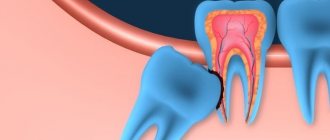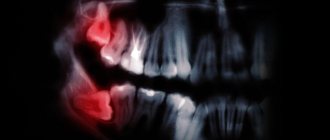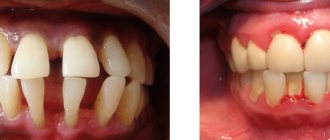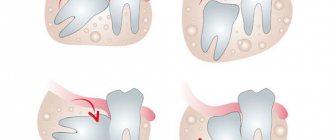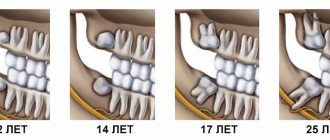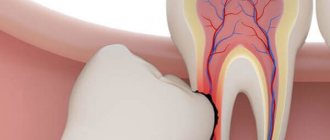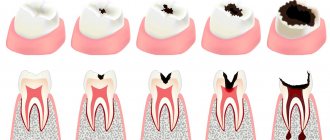In this article
- What is a wisdom tooth and where is it located?
- Why does figure eight caries occur?
- A wisdom tooth affected by caries - treat or remove?
- Pros and cons of treatment tactics for wisdom teeth for caries
- In what cases does wisdom tooth treatment make no sense and must be removed?
- Pros and cons of removal tactics for caries of the lower or upper eights
- Step-by-step treatment of wisdom tooth caries
- How is a wisdom tooth removed?
- Is it necessary to place an implant instead of a removed figure eight?
When caries is detected, there is usually no question of what to do. He is treated immediately. But if caries is found on a wisdom tooth, a person may be faced with a choice - to treat or remove it. We will tell you in this article how to deal with caries of eights correctly.
What is a wisdom tooth and where is it located?
The name “wisdom tooth” is assigned to the third molar, the so-called figure eight, the eighth tooth in a row. The period of wisdom teeth eruption is approximately from 20 to 27 years. In rare cases, they appear after 40 years. It is precisely with the age of eruption that the name of eights—“wisdom teeth”—is associated, because in fact they appear in a person during the period of maximum maturity of the body.
It is interesting that in some people, despite the presence of the rudiments of teeth, they may not erupt throughout their lives. Scientists explain this fact by the fact that in the process of evolution, modern people's jaw has become shorter by about 12 mm compared to their ancestors, which is due to softer food, when chewing which there is no heavy load on the jaw.
If figure eights do erupt, they often cause pain and discomfort to the person. If the jaw is small, then in the process of growth the eights can shift the dentition, which leads to the curvature of other teeth. Therefore, many people try to remove them whenever possible. But the very fact of having a “wise” tooth is not always a reason for its removal.
Structure
Externally, the “eight” is no different from other permanent molars; its uniqueness lies in the following:
- In most cases, teething occurs between the ages of 16 and 25;
- At the moment when the third molar finally appears, the remaining teeth have already taken their places on the jaw, leaving practically no free space. Accordingly, the eighth tooth has to push away its neighbors, which is not always possible;
- Wisdom teeth are extremely difficult to treat because dentists cannot always reach them. And most often, if problems arise with the “eights”, they are simply removed.
Why does figure eight caries occur?
According to statistics, caries of problem eights is much more common than caries of other teeth. At the same time, the main reasons for the development of carious lesions are not much different from those with damage to any other part of the jaw. These include:
- Hereditary factors.
- Poor hygiene.
- Excess sugars and fast carbohydrates in daily nutrition.
- A specific risk factor is the location of the third molar. Typically, the wisdom tooth erupts at an angle, which makes it difficult to properly clean it during daily hygiene procedures. In hard-to-reach areas, food debris accumulates, which serves as a breeding ground for bacteria. By fermenting carbohydrates, bacteria produce organic acid, which leads to caries of the upper or lower 8 teeth.
A wisdom tooth affected by caries - treat or remove?
According to statistics, when affected by caries, in approximately 20% of cases, the wisdom tooth can be treated, in 80% it can be removed immediately. The question of treating or removing figure eights is decided by the dentist, taking into account the individual characteristics of a particular patient.
In what cases can experienced dentists treat caries of third molars:
- If the tooth is in satisfactory condition, the carious lesion is superficial or in the stain stage and there are no obstacles to successful treatment.
- It is very desirable to treat wisdom tooth caries if for some reason the patient has had his sixth or seventh teeth removed and the eights bear a large chewing load.
- Treatment of a wisdom tooth affected by caries is also necessary if the figure eights act as a support for orthopedic structures - bridges, crowns.
- Treatment is acceptable if there is no gingival “hood” hanging over the dental crown.
- It is advisable to preserve the tooth even if the opposite jaw also has a figure eight.
Professional cleaning and braces
If a corrective system is installed to correct the bite, you will have to visit the dentist every 3-4 months. In this case, it can be difficult to achieve high-quality hygiene at home, so professionals come to the rescue.
If hygiene procedures are neglected, caries may develop over time. To do this, you will need to dismantle the structure, which will lead to significant financial costs. In addition, the result of partially completed treatment will be useless.
Having figured out why professional teeth cleaning at the dentist is needed and how the procedure works for certain categories of patients, we can conclude that it is important to carry it out for preventive purposes every six months. If you do not resort to this method of cleansing, you cannot avoid carious lesions, pulpitis and other pathological processes. Accumulated plaque is a favorable environment for the growth and reproduction of pathogenic bacteria, so it is important to get rid of it in a timely manner.
In what cases does wisdom tooth treatment make no sense and must be removed?
- If the dentist has diagnosed “deep caries of the wisdom tooth,” it makes no sense to treat the disease at this stage. In this case, the tooth is simply removed.
- Figure eights affected by caries are removed if they are incorrectly located in the row of the masticatory-maxillary system.
- Extraction (removal) is carried out for chronic recurrent pericoronitis - if the patient regularly has inflamed gums around the eighth tooth.
- The figure eight should be removed if it injures the soft tissues of the inside of the cheeks. This happens when wisdom teeth are incorrectly positioned.
- Treatment of eighth teeth is not carried out if the patient cannot fully open his mouth or there are other obstacles to the procedure.
- Caries will not be treated if the third molars violate the position of the dentition and cause crowding of the canines and incisors. In such situations, the doctor often removes the figure eights and then performs orthodontic correction of the displaced teeth.
- Basal caries and cervical caries of wisdom teeth are also indications for removal in most cases.
Functions
Opinions differ as to why our contemporaries need eighth teeth. Some experts believe that since the “eights” were created by nature and still appear, then they should not be removed unless absolutely necessary. In addition, sometimes the third molar becomes a real lifesaver for fixing a denture. Other doctors are sure that it is better to immediately remove wisdom teeth if they cause concern. After all, these rudimentary organs no longer fulfill their main role - people have long switched to soft foods that have undergone heat treatment.
Pros and cons of removal tactics for caries of the lower or upper eights
Advantages of the extraction (removal) method:
- it is possible to completely eliminate the infectious focus, prevent the spread of the inflammatory process to adjacent teeth and nearby tissues;
- eliminates the risk of crowded teeth and the need for orthodontic correction;
- the risk of recurrent caries is eliminated;
- removal of the third molar allows you to radically solve the issue of pain in the area of this tooth.
The negative aspects of removing wisdom teeth include the risk of postoperative complications, as well as the inability to install a support for bridges or crowns on the figure eights, if necessary.
Step-by-step treatment of wisdom tooth caries
If the dentist gave a positive answer to the question of whether to treat wisdom teeth, it is necessary to begin treatment as early as possible, before caries reaches a more advanced stage. The treatment procedure for third molars is slightly different from the treatment of other teeth in the upper or lower jaw, since due to the special arrangement of the teeth, the doctor cannot use all available technologies.
Treatment occurs in several stages:
- After anesthesia, the dentist carefully prepares the cavity and, using a drill and hand instruments, removes all tissue affected by caries.
- To prevent infection from entering the body, he treats the oral cavity and the tooth itself with an antiseptic solution.
- The dentist places a healing or insulating pad inside the cleaned cavity.
- A seal made of photocomposite material is installed on top of the gasket. It is applied in layers, and each layer is illuminated with a special lamp until completely cured.
- After filling, the tooth is adjusted to the bite, given the correct anatomical shape, ground and polished.
Contraindications
Despite the effectiveness of the procedure, as well as the harmlessness and safety of professional teeth cleaning in dentistry, in some cases, cleansing methods are contraindicated. This is relevant when:
- diagnosing acute infectious diseases of bacterial or viral etiology;
- inflammation of the mucous membranes of the oral cavity;
- minors (under 18 years of age).
There are also individual limitations specific to individual patients. For example, this may include increased sensitivity of incisors, canines and molars, allergic reactions to anesthetic components and other substances. In any case, you will need a mandatory consultation with a dentist; he will consider all the advantages and compare them with possible risks.
Are there any restrictions for pregnant women
During pregnancy, you need to take care of your health, since the mother is responsible not only for her own body, but also for the condition of the child in the womb. The oral cavity should be given special attention. During the gestational period, many types of professional teeth cleaning in dentistry are allowed (as done using ultrasound and other methods, discussed above), but it is important to take into account some points.
The gestation period is of great importance. In the third trimester, the procedure is contraindicated, since due to stress it can cause intense uterine contractions and lead to premature birth. Until the 28th week of gestation, you can have your teeth cleaned by a hygienist if the expectant mother feels well and the gynecologist at the antenatal clinic has not found any contraindications.
When you come to the clinic, you should notify the doctor about your pregnancy. This way you can choose the safest and most effective method of cleansing.
Are there any restrictions for children and teenagers
Some parents believe that baby's milk units do not require careful care and treatment, since they will fall out anyway and be replaced by permanent ones. If oral hygiene is neglected, premature extraction may be required, which will negatively affect the subsequent eruption of molars, canines and molars.
A child should not be taken to ultrasound and laser, since such methods can harm the fragile and thin children's enamel. How the procedure is carried out, professional teeth cleaning is done for small patients:
- a special paste is applied to strengthen hard tissues and prevent caries;
- “Air-Flow” delicate cleansing is performed (over 6 years of age);
- manual processing (the dentist must have extensive experience and a high qualification category).
How is a wisdom tooth removed?
Depending on a number of factors, the removal procedure can be simple or complex. If there are a small number of roots or their weak connection with the jaw, removing a tooth will not be difficult; the entire procedure will take about 20 minutes.
If the tooth is in the wrong position, has not grown completely, is located under the gum, has fused with the jaw, the roots are intertwined with the roots of other teeth, or a cyst has formed, in such situations the removal procedure will be difficult and will take at least an hour.
Any removal of third molars is a dental procedure performed under local anesthesia. It should be performed by an experienced dental surgeon, so contact only reliable clinics.
The removal procedure occurs in several stages:
- First, an x-ray is taken so that the doctor can understand the exact location of the tooth.
- The specialist selects anesthesia taking into account individual tolerance and gives an anesthetic injection.
- After a few minutes, when the anesthesia takes effect, the removal begins directly. Depending on the complexity, the procedure will take from 20 to 60 minutes.
- The doctor carefully makes incisions, removes the affected wisdom tooth, then treats the jaw with antiseptics and, if necessary, applies stitches.
- After the procedure, the dentist gives recommendations on how to care for your mouth and teeth after surgery. Typically, you should not eat for a couple of hours after the procedure, and you should not rinse your mouth forcefully for a while.
- If inflammation is present, the patient is prescribed antibacterial drugs. They will stop the inflammatory process and prevent the risk of infection spreading to other tissues.
Removal Features
As a rule, operations to remove third molars are always considered difficult, since these are the teeth that usually cause more problems. The operation can be simple, provided that the “figure eight” is located on the upper jaw and does not have pronounced developmental abnormalities. In all other cases (as well as in situations where the tooth is in the upper jaw, but has strong, curved and branched roots), the operation is considered complex and must be performed by a qualified dental surgeon.
Before performing an intervention, the doctor determines possible contraindications for a particular patient, examines an x-ray of the problem area and determines the optimal tactics for the operation. The duration of the procedure ranges from 1-10 minutes for simple removal and up to 20-120 minutes for complex removal, requiring a series of manipulations and suturing of the hole.
Is it necessary to place an implant instead of a removed figure eight?
Theoretically, a dental implant can be placed in place of an extracted wisdom tooth that has been affected by caries. But in practice this is not done for a number of reasons. Firstly, the anatomical location of the tooth makes such implantation extremely difficult. Secondly, the load on the eighth tooth will sooner or later lead to loosening of the rod on which the implant is attached. Food will get into the gaps formed and microbes will multiply, which can lead to inflammation. Thirdly, even with proper installation of the implant, there will still be a joint between the gum and the crown, in which bacteria will accumulate if hygiene is difficult.
And finally, replacing a removed figure eight with an implant does not make practical sense, especially if a person’s other chewing teeth function normally. Also, the absence of these teeth does not impair the quality of life and does not affect human health. Therefore, after removing the third molar, there is no need to install an implant in its place.
Lifespan
Despite the fact that third molars erupt later than other teeth, they do not last long. This is often due to the fact that figure eights are difficult to care for due to the difficulty of accessing them with a toothbrush (for the most part this applies to teeth growing at an angle). As a result, the eighth teeth deteriorate and are removed.
It happens that “eights” are affected by caries even before the moment of complete eruption, as a rule, if it lasted a long time and was accompanied by complications. But completely opposite situations are also known, when wisdom teeth do not cause any trouble to their owner. The latter option is explained by the correct placement of the “eights” and regular oral care.
